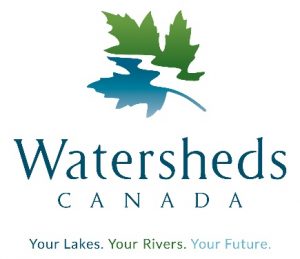2016 Howes Lake – Cole Creek
Howes Lake is a spring fed lake located in the township of South Frontenac, just north of Verona, in Frontenac County, Ontario. It is long lake with a surface area of 153.8 ha and connects with Verona (Rock) Lake that is currently stocked with walleye fingerlings. It has a maximum depth of 12.8 meters and supports a warm water fishery that includes walleye, cisco, northern pike, large and smallmouth bass. Most of the development occurs on the western site of the lake.
Howes Lake is home to a historic walleye spawning bed located on Cole Creek but unfortunately due to beaver damage it has been inaccessible to the walleye during times of spawning. The beaver have blocked the creek in several locations. The residents of Howes Lake wanted to restore and enhance this creek so they contacted Watersheds Canada in March 2016 for help.
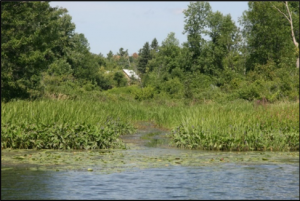
Mouth of Cole Creek that flows into Howes Lake.
Staff from Watersheds Canada, Ministry of Natural Resources & Forestry and Lanark County Stewardship Council met with Robin Pepper a concerned resident of Howes Lake, on August 11th, 2016 to perform a site visit and determine the extent of the restoration that was needed. They hiked into the location of the historic spawning bed, travelling directly on the creek bottom as it was dry due to draught conditions.
It was noted that the spawning bed itself was in good condition as it had been enhanced a number of years previously but accessing the bed was nearly impossible for the walleye due to the number of obstructions blocking the creek. The site is located downstream of Craig Dam, which during the spring large amounts of water flow over this dam creating a flowing waterfall.
After careful planning and consultation with the Ministry of Natural Resources Fisheries Biologists & Conservation Officers, along with the Township of South Frontenac and Quinte Conservation Authority, it was determined that adding more rock to the existing spawning bed, lengthening it closer to the lake was the best scenario. But the main focus had to be eliminating the obstructions to the creek, which meant removing all beaver dams and fallen trees.
Work began in late fall, once the ground was frozen, making it easier for the equipment and to ensure the least amount of damage to shorelines and creek. Equipment was rented, the trapper was hired and volunteers were signed up to start the restoration process. Over a series of several days, the volunteers worked to remove several fallen trees, using chainsaws, winches and tractors to remove the large obstructions.
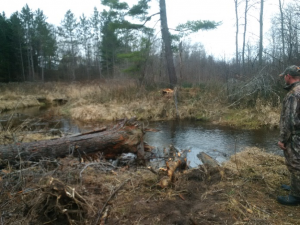
Fallen tree obstruction removed, Cole Creek flowing again.
On October 28th, 2017 the in-water placement of the 40 tonnes of washed river stone took place in Cole Creek. Volunteers placed the silt curtain downstream of the site and silt fencing along the creek’s shoreline according to the work permit, in order to prevent silting of the creek. The use of ATV was donated by property owners to move the silt curtain and other supplies down to the site. Silt fences and curtains were put in place as per work permit, to ensure the least amount of damage to shorelines and creek.
A large tractor/loader was used to move the washed river stone from the road down to the site, one tonne per trip, which took most of the day. And a large high hoe was rented to place the rock in Cole Creek, while volunteers from Howes Lake, Lanark County Stewardship Council and Watersheds Canada spread out the rock by hand.

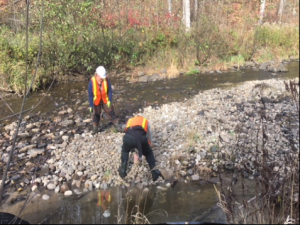
Left: Volunteers set up the silt curtain in Cole Creek; Right: Volunteers help spread out rock amongst the spawning bed
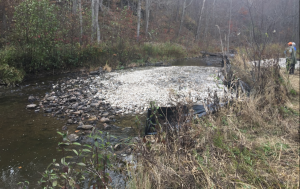
Finished enhanced walleye spawning bed on Cole Creek
This entire project would not have been possible without the support of the many partners and volunteers who made it successful. It was a combined effort involving the Howes Lake Property Owners, Lanark Stewardship Council – Fisheries Biologist, Watersheds Canada. Special thanks to the Department of Fisheries and Oceans Recreational Fisheries Conservation Partnerships Program for the financial support in the competition of the Howes Lake – Cole Creek Walleye Spawning Bed Enhancement Project.
In partnership with grassroots organizations and local volunteers, Watersheds Canada has completed many fish habitat restoration projects across Eastern and Central Ontario over the past nine years, including walleye spawning bed enhancements, cold-water creek enhancements, trout spawning bed enhancements, and in-water habitat enhancements through the deployment of brush piles (woody debris). If you think your Ontario waterfront community could benefit from a fish habitat enhancement project, please check out the free Fish Habitat Enhancement Toolkit: Watersheds.ca/download-the-fish-habitat-enhancement-toolkit/
Thanks to:
Howes Lake Property Owners
![]()

